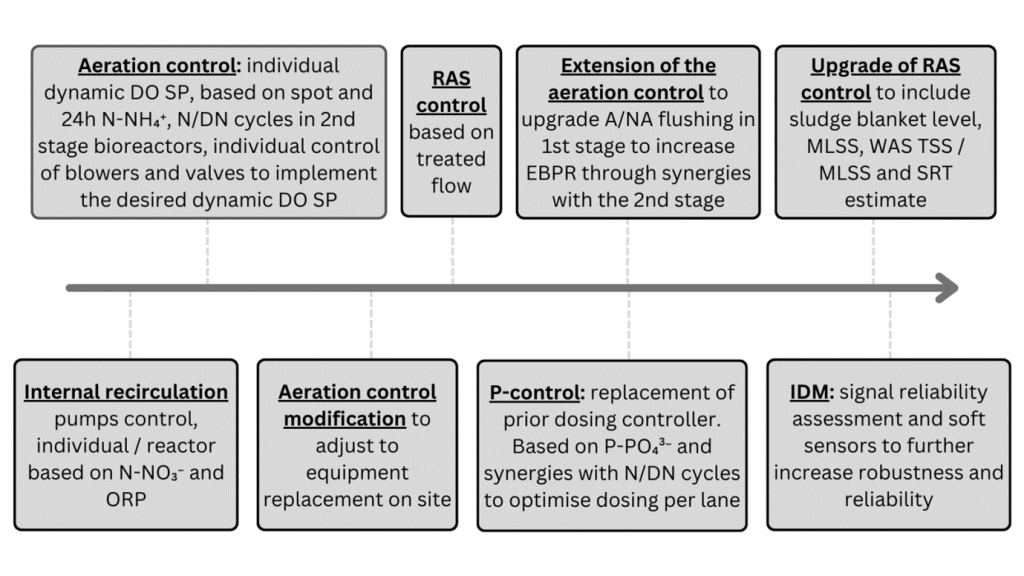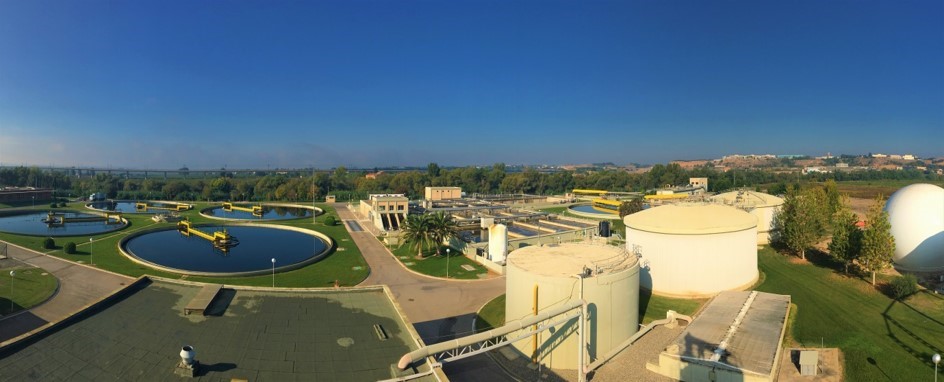Ben Hazard of Te-Tech Process Solutions discusses how advanced aeration control helps maximise the performance of wastewater treatment processes at Lleida wastewater treatment plant, Spain, to ensure consent compliance and reduce energy & chemical consumption
Wastewater treatment is under continuing pressure from all kinds of environmental, sustainability and NetZero targets including ever tightening discharge consents and pressure to reduce chemical usage. Some of these targets conflict with each other but, as energy prices continue to increase; the need to reduce power consumption has become the greatest priority.
Improving process control is fundamental to this, and advances in artificial intelligence (AI) and advanced control systems have shown that there are significant energy savings as well as improved final effluent quality available.
CASE STUDY: LLEIDA WASTEWATER TREATMENT WORKS
The wastewater treatment plant at Lleida in West Catalonia, Spain, treats wastewater (160,000 population equivalent) with a flow of 87,500 m3/day and has been steadily upgrading its control system by installing Createch’s control modules with the CREApro® intelligent control system, which allows the plant to achieve compliance with more stringent consent limits, reduce phosphorus levels, and reduce aeration energy and chemical usage. The consented effluent quality is summarised in the table below:
After grit and grease removal and primary settlement, biological treatment is by the Bardenpho process. The first stage is anoxic denitrification to convert nitrate to nitrogen. Followed by an aerated oxic stage to convert carbonaceous BOD to carbon dioxide and ammonia to nitrate. A final anoxic stage completes denitrification and ferric chloride is added to precipitate phosphate. An internal recycle takes some of the mixed liquor from the second anoxic stage and returns it to the first anoxic stage. Final settlement separates clear supernatant final effluent from activated sludge which is returned to the works inlet with surplus sludge. The largest energy consumers are the blowers used for aeration in the aerated oxic stage.
Conventional aeration control systems
In general, the best way to control the aeration process is to adjust the dissolved oxygen (DO) concentration based on the effluent ammonia concentration. Conventional control systems are based on multivariable PID controllers, adaptative PID controllers, fuzzy logics, adaptive controllers, or predictive controllers. However, some DO control strategies are algorithms in which, besides DO, use the concentration of ammonia and nitrite:nitrate ratio.
However, biological processes are complex and classified as strong non-linear systems, affected by uncertainties like process noise and hidden dynamics that make modelling and control difficult. In addition, data quality and signal availability even from well-maintained sensors, can sometimes be a limiting factor.
Intelligent software can tame the complex process configuration beast
Various advanced digital solutions including machine learning-based methodologies, genetic algorithms, soft sensor and intelligent data management can provide good on-line control not only of aeration but also processes such as enhanced biological phosphorus removal, sludge age control, or nitrate removal control. Although these advanced aeration controllers have been around for several years, systems now have to address multiple goals, which may not always be aligned, using an holistic process line view and multiple KPIs.
The Lleida works shows how intelligent process control can optimise a complex process configuration to meet more stringent consent limits, reduce chemicals use and energy demand and unlock further efficiencies by holistic control.
Step-by-step project timeline
The full optimization project was carried out on site step-by-step. The existing control system was based on manual control, with fixed setpoints. The next stage of optimisation included increased instrumentation (ammonia, nitrate and submetering of flows), and a semi-dynamic control of equipment with settings adjusted manually based on online monitoring readings. A digital twin was also implemented and calibrated to enable process recommendations to support the semi-dynamic control tools. Createch’s CREApro® intelligent platform was implemented to improve process control by enabling actual automatic real-time control, and including more complex logic loops and tools. It was achieved by adding progressively more complex CREA® modules step by step, following an eight year plan.

- Internal recirculation control
Internal mixed liquor recirculation is managed hand-in-hand with aeration cycles, based on nitrate levels as well as treated wastewater flow. This ensures sufficient return to the main anoxic zones, while avoiding any excess unnecessary pumping by reducing, or even stopping recirculation pumps when possible.
- Aeration Control
In terms of air demand control, the control philosophy establishes a dynamic DO setpoint within a configured range, depending on ammonia levels and nitrification performance (conversion of ammonia to nitrate). The system also manages cycles, both nitrification and denitrification based on nitrification performance, denitrification performance, performance targets and other user configuration settings. This approach has been efficient in many instances, both to promote nitrification and denitrification. Alternating aerated and non-aerated phases have also proved effective in boosting enhanced biological phosphorus removal, and this was implemented at Lleida, using dynamically derived set points depending on ammonia, nitrate and phosphorus levels. The nitrification and denitrification cycles are also dependent on certain non-process related inputs, such as time of day and power tariff so that aeration can be scheduled to use lowest cost power.
- Biomass and sludge control
Biomass control is essential to ensure sufficient biomass and sludge retention time for nutrient removal, but also to avoid excess biomass that consumes additional air by endogenous respiration. It is therefore relevant both in terms of process performance, process reliability and treatment efficiency. Two control loops were installed at Lleida. Dynamic control of returned activated sludge flow depends on sludge blanket level, bioreactor mixed liquor suspended solids and waste sludge total solids. Waste activated sludge flow is controlled to a user-defined value for sludge retention time.
- Chemical phosphorus removal and EBPR
Ferric chloride is added in the second anoxic stage to precipitate phosphorus as ferric phosphate to reach the consented limit of 1 mg P/L. In the early stages of the optimization project, a phosphate analyser was installed in the bioreactor effluent stream to allow manual adjustment of dosing but this was later converted to automatic PID control. It was then upgraded using a CREA® control module to optimise dosing hand-in-hand with enhanced biological phosphorus removal.
- Intelligent Data Management
While the CREApro® platform includes some basic signal failure detection and key signal filtering features, an Intelligent Data Management (IDM) module was added in 2021 to provide enhanced and automatic signal reliability and act automatically in case of failure. The main features are online monitoring and alarm of the reliability of the main signals used for process control, automatic switch to alternative signals in case of signal failure and soft sensors for critical signals based on machine learning.
SIGNIFICANT RESULTS
“Implementing the CREApro® proved to be an affordable alternative to upgrading the existing works”, says Site Manager Jordi Palatsi, “The final effluent is compliant with the new more stringent consent limits and phosphorus levels have improved from 0.8 mg P/l to 0.6 mg P/l.” The project showed a reduction of 22% in aeration energy and a 20% reduction in chemical consumption.
The CREApro® intelligent control platform is available in the UK from Te-Tech Process Solutions. For more information contact enquiries@te-tech.co.uk or call +44 (0) 2382 351600.
Reference
Palatsi, J.; Ripoll, F.; Benzal, A.; Pijuan, M.; Romero-Güiza, M.S. (2021) Enhancement of biological nutrient removal process with advanced process control tools in full-scale wastewater treatment plant. Water Research, 200, 117212.

